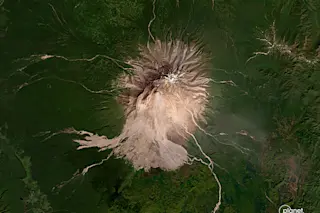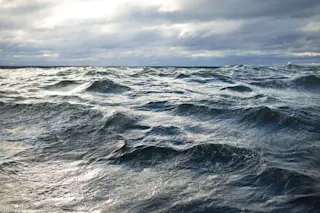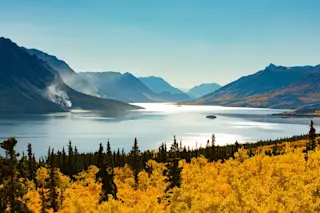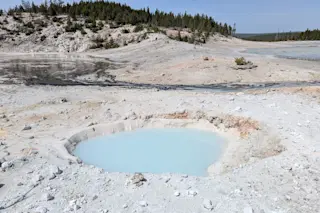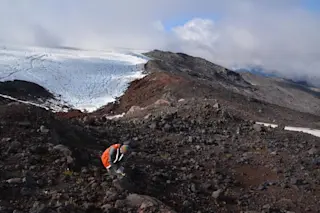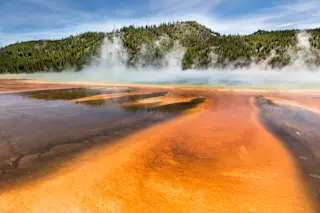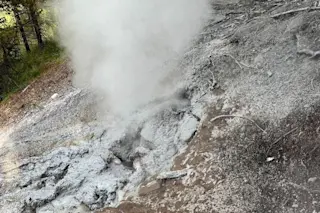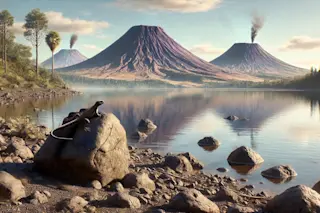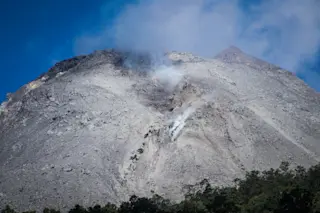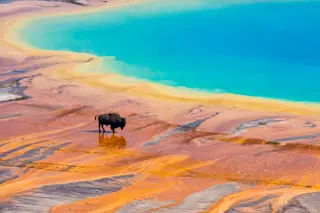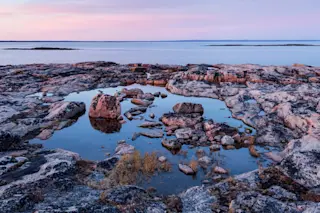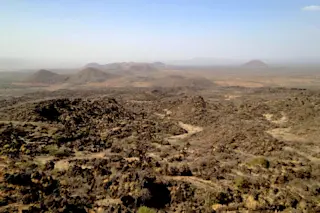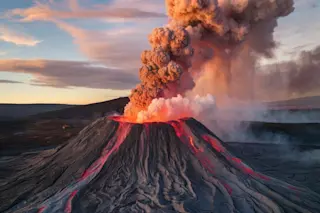On the west coast of the Pacific Ocean lies one of the most active volcanoes on the planet. Shiveluch, located about halfway down the Kamchatka Peninsula in far eastern Russia, has been erupting every year (save for one) since 1984. It has produced some big blasts over the last few thousand years, including multiple eruptions on the scale of Mount St. Helens in 1980. It regularly blasts ash over 30,000 feet skyward and sends pyroclastic flows roaring down its slopes. Shiveluch is a beast.
However, unlike better known but less active volcanoes like Mount St. Helens, Rainier, Vesuvius and Fuji, Shiveluch is remote. The Global Volcanism Program reports a few more than 11,000 people live within 100 kilometres of Shiveluch. Compare that to the four I mentioned before (2.1 million, 2.6 million, 6 million and 25 million within 100 kilometres, respectively) and you can get an idea why Shiveluch is a bit of a unknown volcano to most people.
Volcanoes of Kamchatka
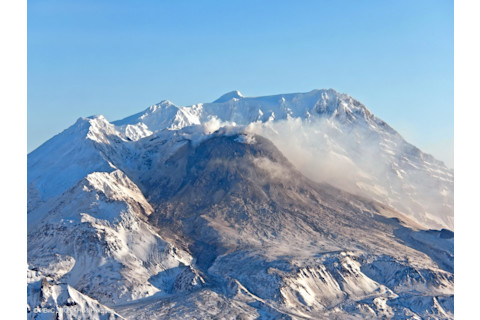
The steaming dome in the crater of Shiveluch in Kamchatka, seen on October 17, 2022. Credit: KVERT
KVERT
What separates Shiveluch from those better known volcanoes is just how active it is. In fact, the volcanoes of Kamchatka are some of the most active on Earth. As a comparison, the Cascade Range in the United States has seen one volcano erupt over the past 100 years (Mount St. Helens), but in Kamchatka, there are currently two volcanoes considering in eruption (Shiveluch and Bezymianny), another on heightened alert (Karymsky) and two more in eruption in the Kuril Islands (Alaid, Ebeko), an extension of the Kamchatka volcanoes off the southern coast.
That level of volcano activity is par for the course in eastern Russia, but it is Shiveluch that is likely the torchbearer for the area. If you see a picture of Shiveluch from the ground (above), you are struck by the fact that it looks a lot like Mount St. Helens. That's because they are very similar volcanoes, both erupting andesite and dacite, usually explosively.
Shiveluch as a long history of violent eruptions. One of these explosions caused part of the volcano to collapse in 1964, giving it that distinct "breached" look (above). Over the past 5,000 years, the volcano has produced 8 VEI 5 eruptions -- that's the same size as the 1980 Mount St. Helens eruption (which has had 8 VEI 5 eruptions of its own over that period).
Collapses at Shiveluch
The style of eruptions at Shiveluch tend to follow a common pattern at continental arc volcanoes. The sticky andesite lava erupts to form a lava dome (above), which builds over days to months. That dome can act like a stopper on a bottle, trapping pressure inside the volcano. That pressure is released catastrophically when the dome collapses (due to gravity), like popping a soda bottle after you shook it up.
The hot dome material either gets pulverised and shot into the atmosphere, sometimes up to 40,000 to 50,000 feet (12-15 kilometres). Some of the hot blocks of lava and ash race down the slopes of the volcano to create pyroclastic flows that travel down river valleys for many miles. If you mix in enough melted snow and ice, you can get lahars (volcanic mudflows) as well. When Shiveluch is having one of these blasts, you don't want to be in the line of fire.
This dome building-collapse-explosion cycle has been cooking at Shiveluch since the mid-1980s -- longer than Kīlauea was in constant eruption from 1984 to 2018. Try to imagine if the same thing happened at Mount St. Helens, where Portland and Seattle had to contend with almost 40 years of repeated explosive eruptions from the Cascade volcano.
Seeing Recent Evidence for Collapse
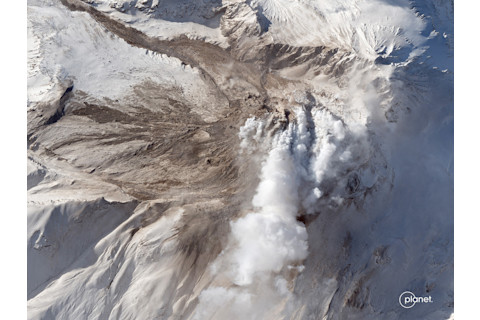
Deposits from a recent dome collapse on Shiveluch in Kamchatka, seen on November 7, 2022. Credit: Planet, used by permission.
Planet, used by permission.
A recent image taken by one of Planet's Dove earth-observing satellites (above) captured the steaming dome in the volcano's crater. Grey-brown deposits of pyroclastic flows extend from the dome in stark contrast to the snows on its slopes. This collapse sent ash 32,000 to 49,000 feet (10-15 kilometres) into the atmosphere, which ash visible in satellite images drifting 250 miles (400 kilometres) to the north.
If you zoom into one of those deposits (below), you can really see the nature of these block-and-ash flows. Large chunks of what was likely hot but solid andesite lava are strewn across the deposit -- some of which are like the size of large appliances or bigger. All of this came down the slopes of Shiveluch at speeds that were likely hundreds of miles per hour and hundreds of degrees. If there was anything in its path up there, it wouldn't stand a chance.
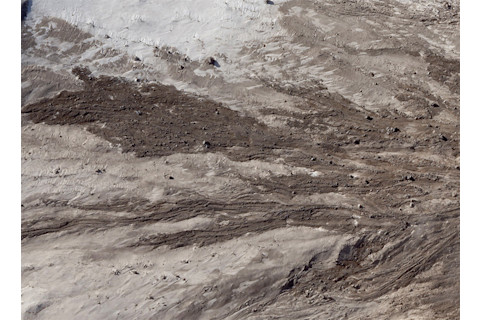
A block-and-ash flow from Shiveluch, showing the large chunks of andesite lava (likely ten feet or more across), seen on November 7, 2022. Credit: Planet, used by permission.
Planet, used by permission.
A Planet mosaic of images from Shiveluch (top) show the extend of the pyroclastic flow deposits on the volcano. The steaming dome is seen just to the left of snow in the image. Most of the pyroclastic flow activity is sent to the southwest, seen as a fan of debris that reaches 10 miles (15 kilometres) from the volcano. The tendrils extending away from the volcano in all directions are stream valleys filled with volcanic debris.
A Hazard from Afar
Although Shiveluch is remote, it is located over what is usually a very busy air traffic corridor (less so today due to Russia's war with the Ukraine). All this ash is a hazard to aircraft, so even without many people living nearby, the volcano needs to be monitored to give airlines warnings to avoid the area.
You can still see the activity at Shiveluch thanks to some webcams pointed at the volcano. The Alaska Volcano Observatory still maintains contact (although limited) with their Russian counterparts at KVERT (Kamchatka Volcano Eruption Response Team) because eruptions on the peninsula could impact US aviation. AVO scientists are always ready to assist with monitoring and interpreting volcanic activity in Kamchatka if the need arises.
In the end, volcanoes are hazards that clearly transcend national boundaries. Shiveluch might not be known by many, but it is clearly seen as a threat to the people monitoring volcanoes on a daily basis.


